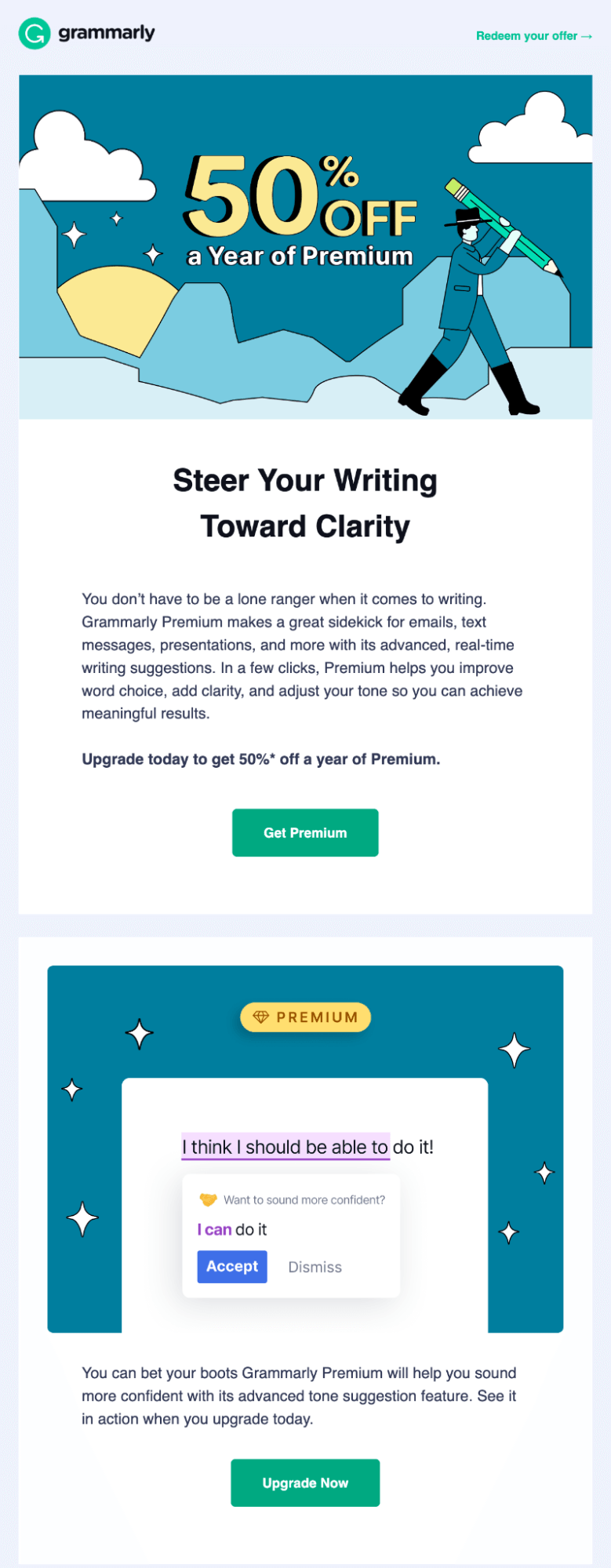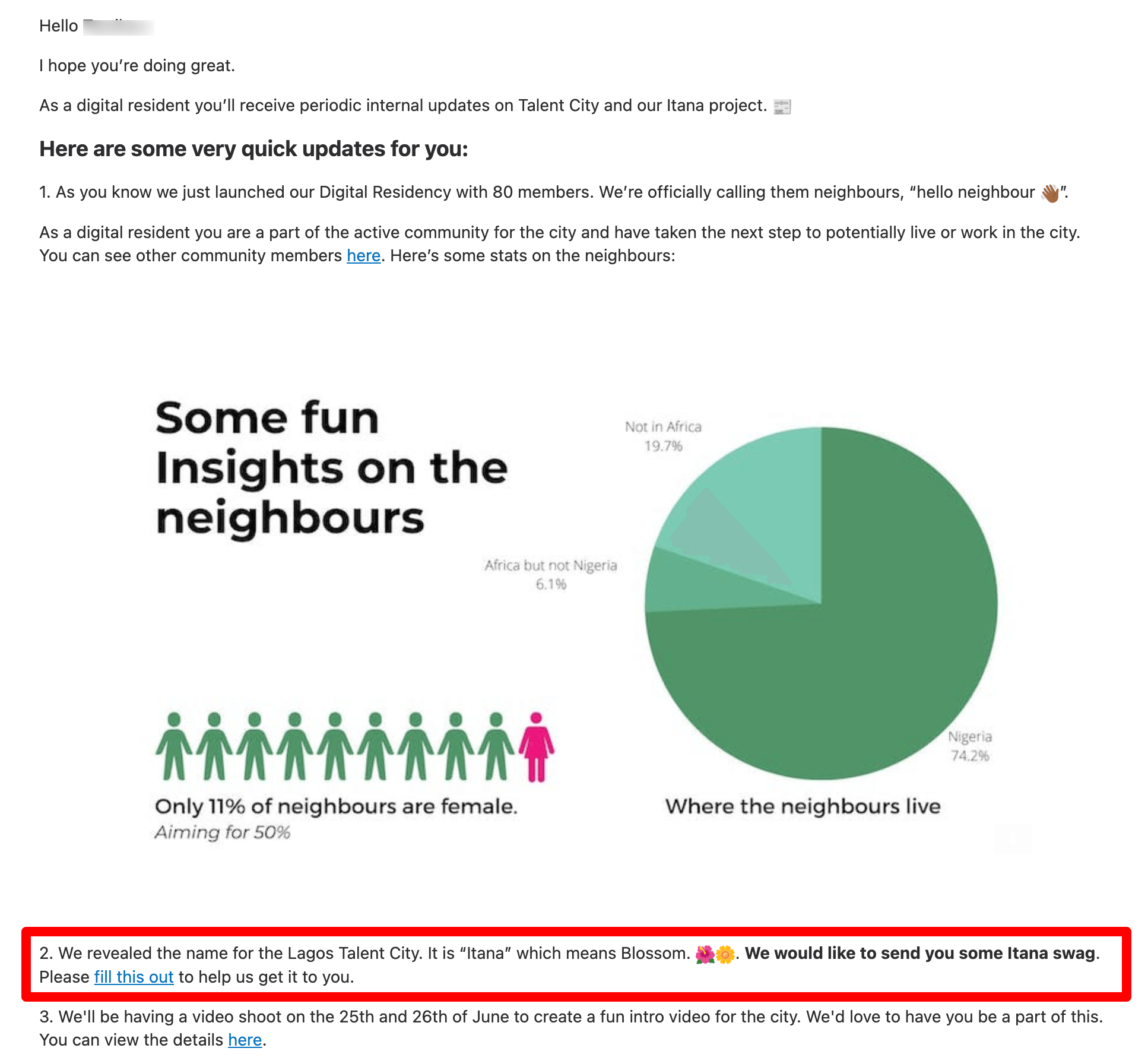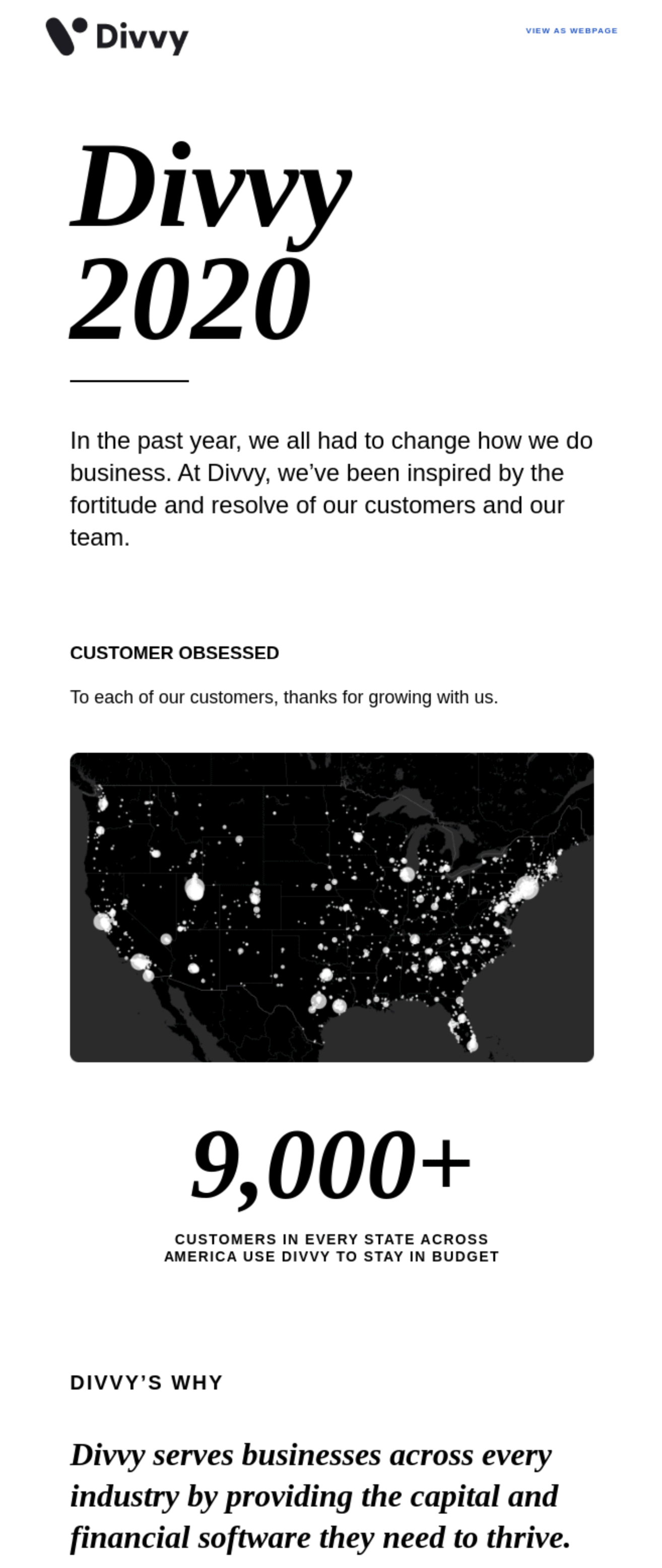A good email does two things: inform the reader, and engage them. As a B2B marketer, you've already got the first thing down. But engaging the reader is a different story.
True engagement comes from the email content.
What exactly can you share with your list? What exact things do you write in your emails to drive engagement?
In this post, we share some content ideas for SaaS email marketing along with examples from SaaS brands to inspire you.
Don't wait for the muse. Apply this step-by-step method to write high-performing email campaigns in hours, not weeks.
Tips for writing engaging emails
Be genuinely helpful
Be helpful and provide real value. People can sniff out the selfish brands that only care about themselves and their pockets vs. those that provide practical, useful information to help them solve their problems. Guess which one they'll engage with and show up for?
Urge them to do something
"Ask, and it shall be given unto you," says the Holy Bible. If you don't ask your subscribers to do something, they won't. Therefore, in almost all your emails, you should urge them to either click a CTA button or reply. The goal is to get them to actively participate.
Balance asks vs. gives
Gary Vaynerchuk coined the "Jab, Jab, Jab, Right Hook" principle. It entails providing value to customers multiple times (throwing a jab) before asking for something in return (throwing a right hook.)
This is not to be confused with the previous point which says you should almost always urge your reader to do something. 'Urging' doesn't have to be selfish. You could urge them to click to read an article, redeem a voucher, or do something that is entirely for their benefit aka "throwing a jab."
Give more than you ask, but don't feel weird for asking after providing value.
Personalize your campaigns
Have you ever received an email and it seemed like it was written just for you? Wouldn't you be more inclined to respond or act on such an email?
That's what personalization (and segmentation) does.
Messages that speak directly to the reader's interest or problems foster engagement because it makes them feel special and understood. Dynamic content makes them even more personalized.
Like Abhishek Shah, founder of Testlify says:
"I use dynamic content to personalize the email's subject line, introduction, and call-to-action, which has resulted in an increase in open rates and click-through rates."
Keep them short and sweet
It's not news that most people only scan emails or even any type of content. People are not likely to read your email word for word.
In fact, an old Nielsen Norman report shows that people scan emails 81% of the time. According to another report, we spend an average of 10 seconds on reading an email. This makes it imperative for marketers to ensure their emails are skimmable to promote engagement.
How?
First, by making them short. No need for long-winded texts. However, it shouldn't be too short that it comes off as flat. As this Atlantic article posits, the perfect email message is "short and sweet — but not too short or too sweet."
Second, add lists as much as you can. They promote scannability. And for the parts you want the reader to pay particular attention to, format them in bold to highlight them.
Make them interactive
Elements like images, gifs, and videos make content more interactive. They help break up large blocks of text and grab the reader's attention. So where possible and relevant, add these elements to your emails.
Consider plain-text emails
Finally, consider crafting plain text emails. Sometimes it's just what your audience needs, not the fancy graphics. They can also foster more meaningful relationships and boost engagement.
For instance, Milo Cruz, chief marketing officer at Freelance Writing Jobs, shares how he tested plain text emails from HTML emails, and the responses he got were overwhelmingly positive.
"Most customers showed excitement and commented on how they quickly understood our message due to the email's clarity and conciseness."
8 email content idea groups to drive engagement
Many marketers limit themselves to the regular onboarding, upgrading, and reactivation type of emails. But there are so many more content ideas for SaaS email marketing which we expand on below. These ideas are grouped into the goals that can help your brand achieve such as:
- To educate
- To drive conversions
- To show appreciation with gifts & freebies
- To make requests
- To entertain
- To build relationships
- To share company-related content
- To share product-related content
Let's dive into more details.
To educate
Remember the "Jab, Jab, Jab, Right hook" rule? One way you can throw a jab is by sending purely educational (and engaging) emails. These emails aim to provide information to help the reader solve problems or answer questions they might have. They include:
How-tos and tutorials
This short email from WP Mail SMTP promises to show the reader how to solve the problem of contact form spam.
Subject line: Contact Form Spam Slowing You Down?

Case studies
Another way to educate people is by sharing your case studies like this one by Airtable.
Subject line: Marching into spring with Airtable

Templates & checklists
Sometimes, you should provide templates and checklists to help your readers do something more effectively. Here's an example from Notion.
Subject line: Notion for Marketing teams (2/5) / Execution & tracking

Best articles
A roundup of the best articles you published that week/month is another idea that is sure to educate and engage your audience. Compile the ones you think are most relevant, add short paragraphs to explain what each is about, and include the CTAs to read them.
Semrush does this so well in their "Learning with Semrush" emails.
Subject line: Create powerful content

Video materials
You shouldn't only send text content: mix it up sometimes with video. If you've just posted a video content on your YouTube channel or your blog, share the link with your audience like Kittl.
Subject line: This niche is selling super well in print on demand! 👀

Podcast episodes
If your brand has a podcast, another content idea is to introduce your subscribers to new episodes. A number of them could be interested in listening and sharing with other people. Take a look at this email from Kajabi.
Subject line: Get a competitive edge with Kajabi

Live events
From time to time, organize webinars to educate your audience. You can inform them about such events via email, and tell them why they should attend. Take this example from Calendly.
Subject line: You're invited: How to use Calendly Routing to convert more leads.

To drive conversions
Revenue is the core of a business. So to drive conversions, encourage customers to act immediately. There are so many ways you can do this via emails like:
Discount
Sending out promotions is a classic, but don't overdo it. Otherwise, your brand is going to be known for always offering discounts, and people will hardly ever buy at full price again. Give discounts sparingly. And when you do, the emails should look something like this one from Grammarly.
Subject line: Save 50% and saddle up for better writing! 🤠

Expiring timelines
You can also remind them about discounts that are expiring soon. See Zero's email for inspiration.
Subject line: Save 40% on Zero Plus — this week only!

Here's another example from Gumroad:

Limited availability
How about an offer that rarely happens?
The example below from Semrush does two things: it encourages people to upgrade, while also making them feel good about themselves because a portion is going to a non-profit organization. People are going to be more inclined to take up this offer.
Subject line: Limited-time offer: Plant new trees with your Semrush plan

To show appreciation with gifts & freebies
This is another 'jab,' and the aim is to make your customers feel special and appreciated. The emails you can send to achieve this goal are:
Company swag
If your business can afford it, give swag to your customers or members. Itana did this for their founding members.
Subject line: Itana June Update for neighbours

Vouchers/gift cards
Who doesn't love free stuff?
Free vouchers/gift card content drives engagement, and you can either gift them these with no strings attached or ask for something like a review like 15five did.
Subject line: [Survey] $25 Gift Card - How was your trial experience?

Other types of goodies
Another way to give back to your audience is to offer free tickets to industry events, or even subscriptions to communities, products, or services relevant to them, and complimentary to your product (not competing).
The Freelance Coalition For Developing Countries does a good job of giving out free tickets from sponsors via email.
Subject line: Awesome opportunities for you, (Name)!!! 🥳

Challenge (with a reward for the winner)
Challenges excite people, no doubt. It brings out the competitive spirit in them. Use this to your advantage by setting weekly/monthly/seasonal challenges, and inviting your customers (via email) to participate with a prize for the winner.
Canva's earth day challenge is a good one to study and replicate.
Subject line: Design for Earth Day! 🌍🌳

Don't wait for the muse. Apply this step-by-step method to write high-performing email campaigns in hours, not weeks.
To make requests
Now for a 'right hook.' Ask your audience for something in ways like…
Surveys
Notice any new or even dying trend? Ask your list what they think about it. Semrush did this effortlessly in their email below.
Subject line: Is everyone still talking about SERP features?

Feedback/testimonial
Has a customer recently used your product for the first time or even for a few weeks/months? Ask them for feedback just like Sumo Logic did.
Subject line: Tell us what you REALLY think

Refer-a-friend
Another 'request' idea is to implore readers to refer your product to their friends. Throw in some extras to sweeten the deal for them. Kittl, a design tool, does this so well.
Subject line: Invite your friends to Kittl and earn rewards 🥳

Software reviews
People don't buy without first scouring the internet for reviews from other satisfied buyers. That is why sites like G2, Capterra, TrustRadius, and GetApp are so popular in the B2B SaaS world. You can take advantage of this by encouraging satisfied users to leave reviews on these sites for your brand. Here's an example from Supermetrics.

To entertain
Entertaining your user is one of the best ways to create engagement. A fun email is a rare find in the ocean of product emails. It could be entertaining content, or entertaining activities like games.
Here's a fun 'jab' idea: send your users a mini game or quiz they could play and share their achievement with others. Spotify did this for their K-Pop campaign.
Subject line: Discover Your K-Pop Persona

To build relationships
These types of content aim to build a closer relationship with your list as this type of relationship can help drive better engagement and conversion. You can do this by sending messages on…
Holidays & seasons
Ideally, you'll have customers of different races, ethnicity, and religion. Acknowledge and celebrate important holidays for your customers. For example, you can send a simple, yet beautiful Merry Christmas card for those who celebrate the holiday just like Barter.
Subject line: Merry Christmas! ✨ from the Barter Team at Flutterwave! 🎄

Customer success stories
You can spotlight one of your customers and share their story, especially when it ties into your product. Semrush (can you tell we're fans of their emails?) is one brand that does this so well.
Subject line: [Meet Gaby] SEO by day, DJ by night.

Celebrating customer milestones and anniversaries
Don't forget to celebrate your customers' milestones and anniversaries like this one from Grammarly.
Subject line: New badge, new badge, new badge!

Or this anniversary celebration from Namecheap.
Subject line: Happy Nameaversary!

To share company-related content
It is also necessary to lift the veil covering your company's inner workings to let your customers in. It makes them feel more connected and builds brand loyalty. Email examples in this category are:
"Year in review" reports
This should be sent either at the end of the year or at the beginning of the new year. In it, you're providing a summary of your company's wins, losses, and achievements in 365 days which is exactly what Divvy did in their review.
Subject line: 2020 Year in Review

Reports about team events, rituals etc
What are some activities or events peculiar to your team? Share these with your audience like Triple Whale did.
Subject line: 🐳 Inside the Whale #006

"How we do X"
If your company recently tried out something or has a different way of accomplishing a task, it is worthwhile to share too. Like Substack, who raised funds in an unusual way.
Subject line: Thank you to Substack's newest investors

To share product-related content
Product-related content includes information you want customers to know about your product, and which they might miss on their own.
Product updates
Send them regular updates on what the product team has been up to. Zapier does this well.
Subject line: Your monthly roundup of Zapier product updates

New features/integration
Just released a new feature or integration? Why not let subscribers know? Especially if it's an in-demand one. When Buffer integrated with Canva, they shared it with their list.
Subject line: New! Share Canva designs instantly with Buffer ⚡

There you have it. 26 content ideas to drive email engagement for your SaaS.
But it doesn't end there. You also need to track your audience's behavior.
Monitor audience behavior to increase engagement
Once you start sending emails to your list regularly, you need to pay attention to their behaviors as it could provide valuable insights to help engage further. Here are some of the metrics you should monitor.
#1. Open/bounce/unsubscribe rates
How many people on your list are successfully receiving your emails? And of those who are, how many opened or unsubscribed?
If you have this data, you can know whether people are interested in your emails or if the frequency is right. And from there, figure out how to get them more involved.
#2. Monitor spam complaint rates
If people are hitting the spam button on your emails, the level of engagement is certainly going to be low. Monitor the rates of spam complaints to know if and when your campaigns need a revamp.
#3. Track email responsiveness
The behaviors of your audience in terms of actual reading also affects engagement. Track to know the placement across devices, and the mode (light or dark), then optimize for those metrics.
#4. Track performance with conversion goals
Some conversion goals include click through rate (CTR), downloads, or upgrades. You should test your emails regularly to see if they are meeting your conversion goals. This is a feature that will soon be available on Userlist.
#5. Identify clear winners and analyze what they have in common
From time to time, collate and analyze your most successful emails to know what they all share. It might be the content, the design, or even the length. Whatever it is, once you've identified it, implement it in subsequent campaigns.
#6. Experiment with subject lines
Many people open brand emails because of the subject lines. So it makes sense to try different subject lines to see which one they resonate with most, then create more along those lines to boost engagement.
Start engaging your audience with the email content ideas above
The ideas above are not exhaustive. There is so much more you can be doing with your email marketing, but they are a good starting point. Invest time and effort into crafting good emails, because the body goes a long way in engaging people.
Check out Userlist's library of email examples to get inspiration for your next email.
If you need top-level help with your email marketing strategy, the best place to start is this guide or a free consultation call with Jane.
Happy emailing!
Don’t miss out on new articles. Subscribe to our newsletter and get your monthly dose of SaaS email marketing insights.





